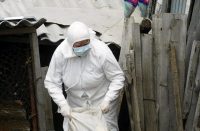In a small Indonesian village on Java Island, tofu production has taken on a new role — by using its waste water to produce biogas, it’s now cutting costs, preserving energy and protecting the environment.
Kalisari village, which now has over 240 tofu workshops, recently became the experimental ground for Indonesia’s Agency for the Assessment and Application of Technology (BPPT), which is pioneering the project.
“Now, as a bonus, the tofu is also a source of energy. The energy can be used in households, like cooking. And it is not that the government only provides us with biogas, the main purpose of this energy to largely reduce environmental pollution,” said Siswo, a tofu producer in the village, who says his business and family has benefited from the technology.
Like in many Asian countries, the soybean-based dish, tofu, which is also known as beancurd, is popularly consumed by families in Indonesia. According to BPPT, there are over 84,000 tofu factories throughout the Indonesian archipelago that produce about 2.56 million tonnes of tofu per annum.
But waste water from tofu production is a serious environmental pollutant due to its high concentration of COD (Chemical Oxygen Demand), and if directly discharged into the environment, produces bad odours and greenhouse gases, polluting both water and soil, a study from BPPT found.
Instead of dumping the waste into river directly, tofu factories in Kalisari now filter it through an underground sewage system to treat it in fixed-bed reactors. The organic waste is treated by methane bacteria, producing both biogas and waste that has been almost completely cleaned of COD. The biogas is delivered to households, and the waste then discharged into rivers or paddy fields.
“The content of COD (Chemical Oxygen Demand) and BOD (Biological Oxygen Demand) in the organic waste is digested by bacteria so that the content of COD (in the waste) drops by 80 to 90 percent, and between 70 to 80 percent of the methane gas produced that can be used directly,” said Widiatmini Sih Winanti, BPPT’s head of environment technology.
BPPT, which is running similar projects in seven other Indonesian cities, projects the technology will help to reduce the country’s greenhouse gases emissions by 26 percent by 2020.
The reactors in Kalisari village currently have the capacity to produce 269 times more biogas than needed every day, said Suwanto, the head of the village.
“This village produces about 24,500 litres of biogas and we turn it round for public use. The community uses an average of 91 litres of biogas within 24 hours,” he added during his daily inspection of the facility.
Locals said they were pleased with the system, and that their living costs had reduced significantly. Biogas, one villager said, is 10 times cheaper than liquid petroleum gas.
“I prefer to use biogas instead of LPG (Liquid Petroleum Gas). If use LPG, the family can use three to four canisters a month,” said Harmini. “If using biogas, I only need to spend about 10,000 rupiah ($0.75) a month.”
Liquid waste from industrial processes in Indonesia are high, and could result in the equivalent of almost one million tons of carbon dioxide emissions per year, BPPT says.
Biogas, therefore, offers a cheap but renewable and sustainable energy alternative to fossil fuels or sources of energy.







